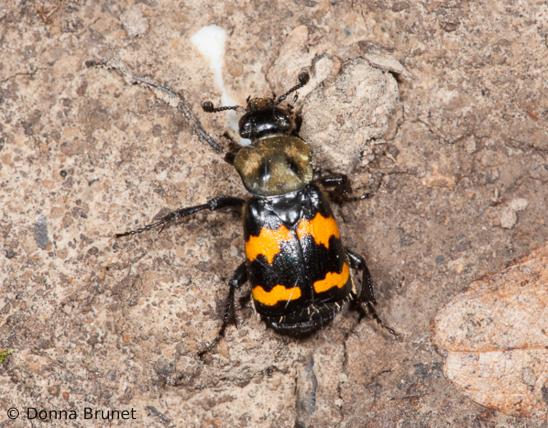
Like other true flies, blow flies have only one pair of wings, short antennae, and large compound eyes. Distinguishing them from other kinds of flies, blow flies are often shiny, metallic, blue, green, or black, with hairlike bristles. Special details of antenna anatomy, wing venation, and placement of body bristles are used by experts for exact identifications.
The larvae are grublike maggots that are tan, whitish, or brownish.
Length: about ¼ to 1 inch (varies with species).

Statewide.
Habitat and Conservation
Adults, being agile fliers, can be found nearly anywhere. As with most insects, they are especially attracted to the places where they deposit eggs. In this case, it’s on carrion or excrement, or on the unlucky animals they parasitize. Adults also often visit flowers, taking nourishment there, and they often rest on outer walls of buildings.
Food
The larvae, hatching from eggs laid on or near their food items, eat carrion or dung. Some species are parasitic and eat tissues or blood from living hosts. Screwworms are livestock pests, attacking at the nostrils, open wounds, and other tender places. Living or dead, flesh infested with fly maggots is called “fly blown,” a term going back to Shakespeare. Meanwhile, adult blow flies sustain themselves by eating nectar and pollen from flowers, often pollinating the flowers in the process.
Status
Common. Livestock and pets can be afflicted with myiasis, when botflies, blowflies, or screwflies parasitize them. It’s rare for humans in our country, but people in tropical areas face parasitism by botflies and others, whose larvae feed internally or just under the skin, creating boil-like sores. Screwworms, once a huge problem for livestock, have been eradicated in North America by the USDA introducing irradiated, sterilized male flies into the population.
Life Cycle
Blow flies, like all other members of the fly family, go through complete metamorphosis, starting out as eggs, which hatch into grublike larvae (maggots), which feed, grow, pupate, and then emerge as winged adults capable of reproducing. In some species, a female can lay thousands of eggs in her lifetime, usually up to about 200 at a time. Most maggots one sees in a dead animal are blow fly larvae. When fully grown, larvae usually leave their food source and burrow into the ground to pupate.
Human Connections
Many species transmit disease and parasitize livestock and humans worldwide. The carrion and dung eaters help clean up offensive matter. Detectives use the predictable sequence of maggot growth to determine time of death in crimes. Surgeons sometimes use blow fly larvae to clean infected tissues.
Ecosystem Connections
To attract blow fly pollinators, several plants worldwide have evolved flowers that stink and look like rotting meat, including the pawpaw, some tropical arum species you may see at a botanical garden, and cactuslike stapelia houseplants from South Africa, whose flowers look like giant open sores.






























